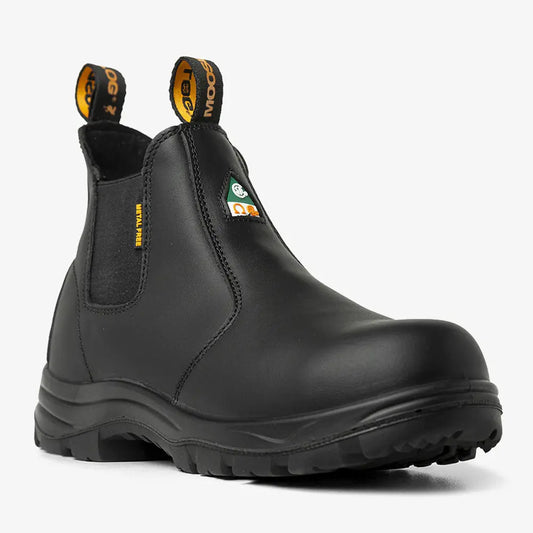When you spend hours on the job, safety and stability are as critical as comfort. A single slip can lead to injuries, lost time, and serious setbacks. That’s why slip-resistant soles are one of the most important features in a work boot. But what actually makes a sole slip-resistant? It’s not about slapping on a rubber outsole and hoping for the best. There is science behind it, from material compounds to tread design and testing protocols.
This article explores how slip-resistant soles are built, the role they play on different surfaces, and how you can tell if your boots are truly safe.
Why Slip Resistance Matters on the Job
In many industries, slips and falls are among the most common workplace accidents. Wet floors in warehouses, oil spills in kitchens, or icy outdoor surfaces can turn any jobsite into a hazard zone. Even highly skilled workers are vulnerable if their boots lack proper traction.
Slip-resistant soles are designed to grip under pressure and maintain stability on unpredictable terrain. They help reduce the risk of falls on smooth, oily, or uneven surfaces. Whether you are moving heavy equipment, climbing ladders, or working in fast-paced environments, reliable traction can make all the difference. It’s not only about protecting yourself but also about maintaining productivity and confidence on the job.
What Makes a Sole Slip-Resistant?
The science of slip resistance comes down to three main factors: rubber compounds, tread patterns, and surface contact.
1. Rubber Compound
The type of rubber used in the outsole determines how well it grips. Soft rubber provides better friction on smooth surfaces but wears out faster. Harder rubber is more durable but can feel slippery on slick floors. High-quality work boots use a blend of rubber materials that strike a balance between grip and longevity.
2. Tread Design
The outsole pattern plays a huge role in traction. Wide lugs with deep grooves channel water, mud, and oil away from the surface, preventing hydroplaning. Smaller micro-patterns create additional contact points that increase grip. A well-designed tread combines both deep and shallow patterns to perform across multiple conditions.
3. Surface Area
The shape and thickness of the sole affect how much contact it makes with the ground. More contact points generally improve traction. A poorly designed sole with flat, shallow grooves won’t disperse liquid effectively, leading to a higher risk of slips.
Different Types of Slip-Resistant Soles
Slip-resistant soles are not all created equal. Here are some of the common outsole types you’ll find:
Oil-Resistant Soles
These are made for environments like automotive shops or kitchens where oil and grease are common. The rubber compound is treated to resist degradation while offering a firm grip on oily surfaces.
Heat-Resistant Soles
Designed for high-temperature environments such as welding or metalwork. These soles not only resist slipping but also withstand extreme heat.
Multi-Surface Soles
Some soles are engineered to handle multiple terrains, from wet warehouse floors to gravel and concrete. These often feature hybrid tread patterns with channels for water dispersion and harder edges for rough ground.
Indoor vs. Outdoor Slip Resistance
Indoor environments often require softer rubber for smoother floors, while outdoor boots need more aggressive lugs to dig into dirt, snow, or mud. Choosing the wrong sole type can compromise both comfort and safety.
Lab Testing and Safety Standards
True slip resistance is not based on guesswork or marketing claims. Reliable boots are tested according to industry standards like ASTM F2913 or CSA Z195. These tests measure the outsole’s coefficient of friction (COF) on surfaces coated with oil, water, and other contaminants.
During testing, a boot is pressed against a wet or oily surface at a specific angle, and the amount of resistance is measured. A higher COF score means better traction. Certified boots provide documented proof that they can perform under real-world conditions.
Many manufacturers also conduct in-house tests on concrete, steel, and tile. This ensures that the outsole performs consistently across different environments. Always look for certification markings on the product page or inside the boot to confirm that your footwear meets safety standards.
How to Tell If Your Boots Are Truly Slip-Resistant
Not all boots marketed as “slip-resistant” are up to standard. Here’s how to check:
- Inspect the outsole: Look for patterns with deep grooves and angular lugs that can channel water or oil. Smooth soles will rarely offer good grip.
- Check materials: Quality slip-resistant boots use high-grade rubber compounds that feel firm yet tacky to the touch.
- Look for certification: ASTM or CSA-certified boots will clearly state their safety rating.
- Field test your boots: If you feel yourself sliding on smooth or wet surfaces, your boots might not have the right level of traction.
Why MooseLog Boots Use SafeTread™ Rubber
At MooseLog, slip resistance is not an afterthought. Every outsole is built with SafeTread™ rubber, a compound designed for reliable grip across multiple surfaces. The tread pattern is engineered to disperse oil, water, and debris while maintaining strong contact points for stability.
Our boots are tested to meet both ASTM and CSA traction standards. The result is footwear you can trust on the job, whether you’re moving across wet concrete, climbing equipment, or handling heavy materials in a fast-paced warehouse.

Final Thoughts
Slip-resistant soles are more than a design detail. They are a critical safety feature that can prevent injuries and boost performance on any jobsite. From the rubber compound to the tread pattern, every detail matters.
When choosing your next pair of work boots, don’t just look for durability and style. Check for safety certifications, inspect the tread, and make sure the soles are engineered for the surfaces you face daily. Your boots should work as hard as you do.





